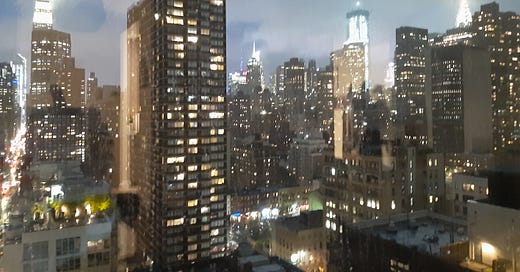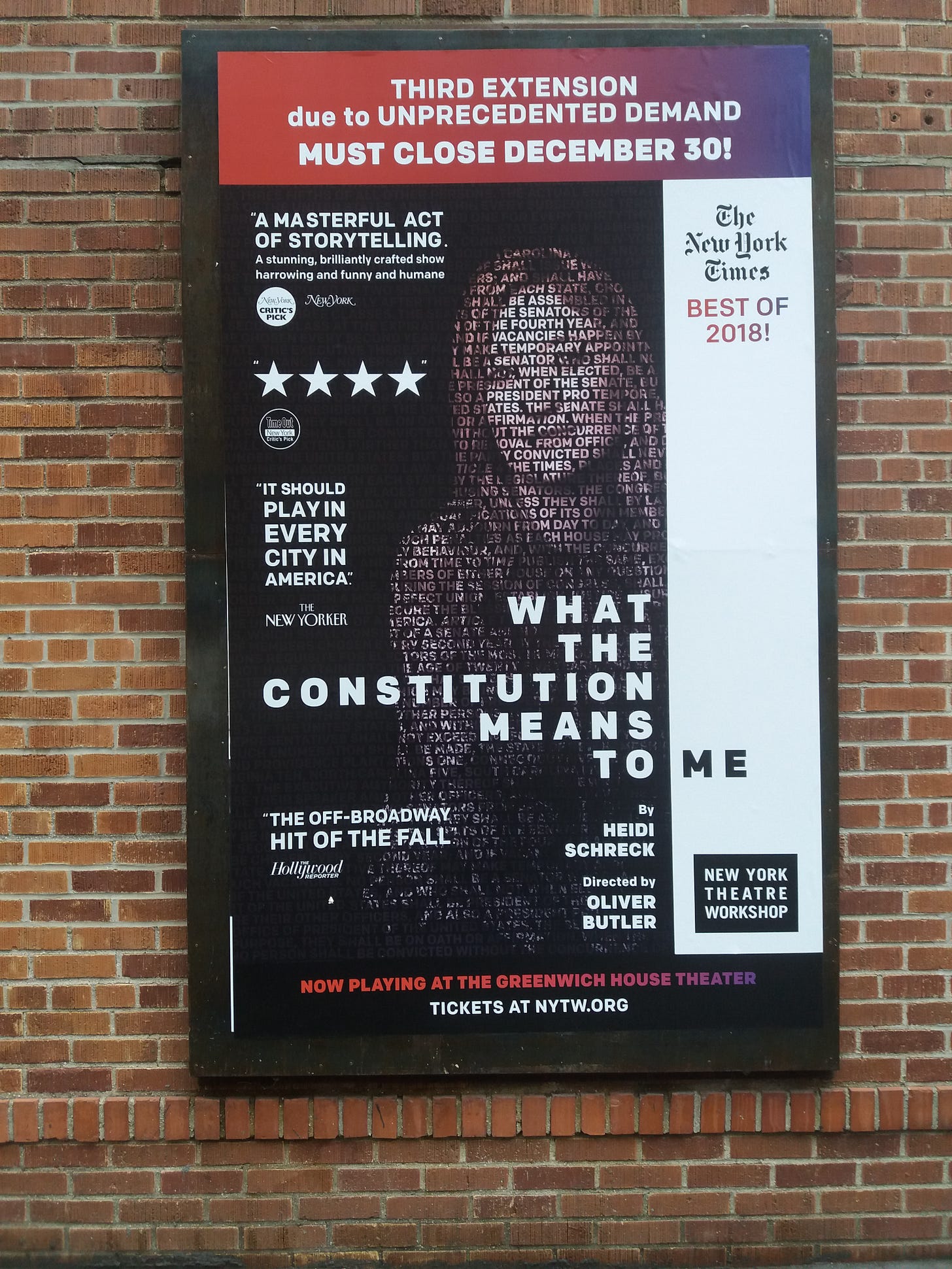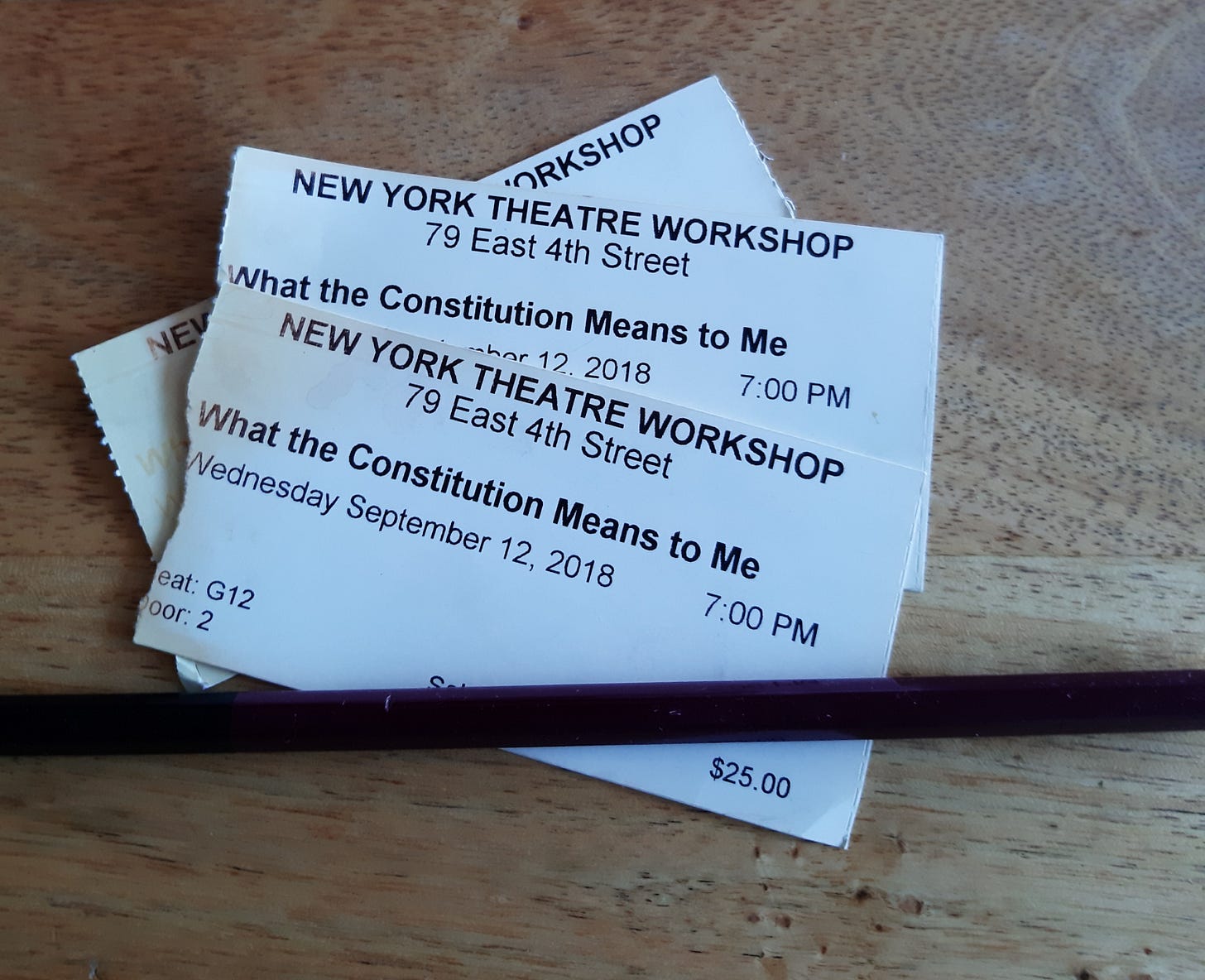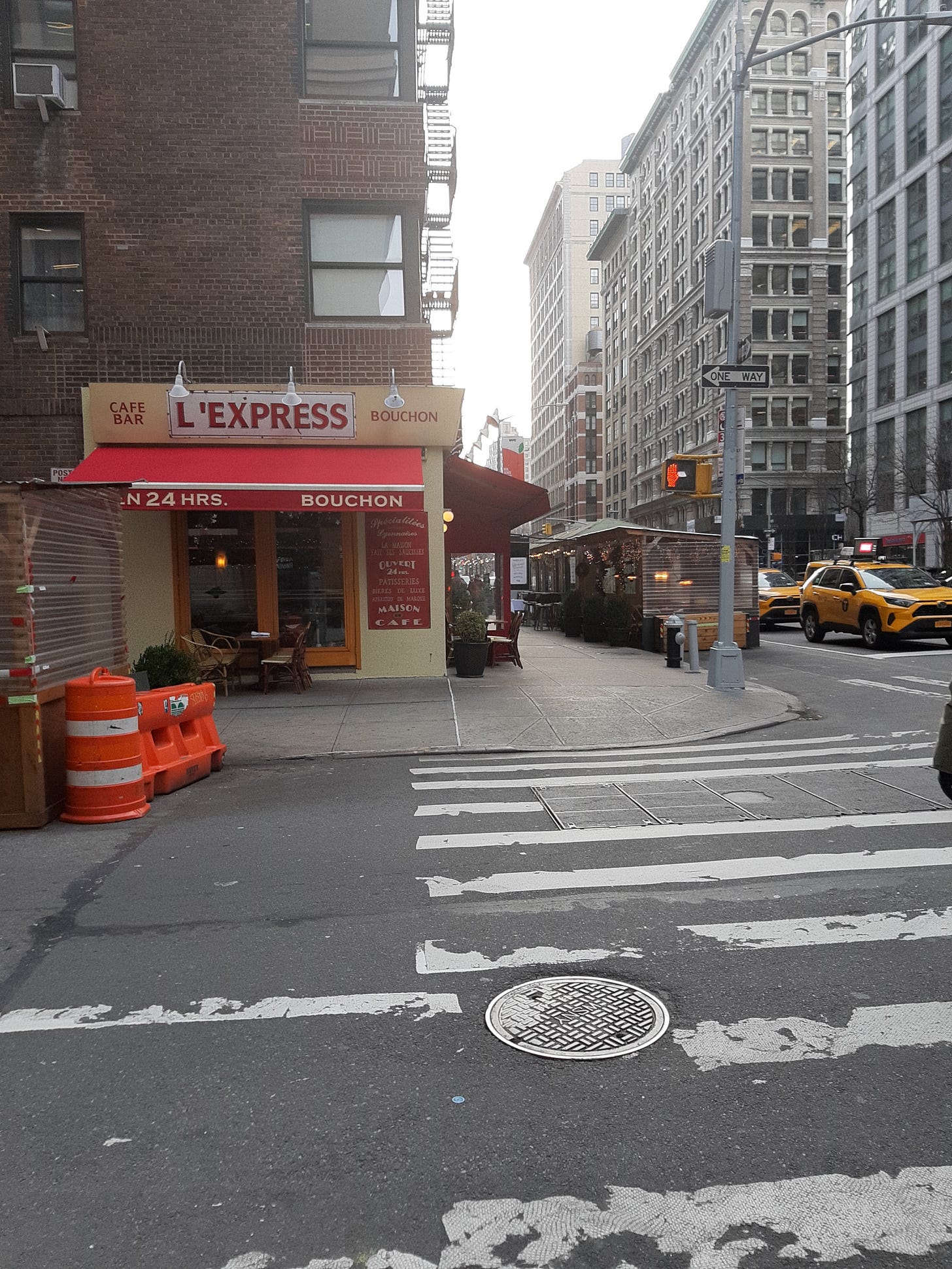April, 2021
The City was beginning to feel a bit like its old self again. The mayor had filed an ordinance back in June of the previous year, commandeering roads and parking spaces for curbside dining, but now, almost a year later, the streets had a truly European feel to them. The vaccination program was making New Yorkers more optimistic, less wary of eating out: on separate occasions in my apartment’s elevator an older woman of Jamaican heritage and a young white male, proudly told me that they were fully vaccinated, New York Tough! Limited indoor dining had just been approved. The sidewalks were beginning to have foot traffic, not anything like before the pandemic but it was something; walking, I had to be mindful once again of hatchways - not unceremoniously tumbling into the basement of restaurants as deliveries were made. I had missed the New York I had grown to love in the three years we had relocated here: overhearing loud, brash phone conversations in the streets that sometimes sounded like a hit was being made on someone; the kindness, generosity of New Yorkers - the surprise of a compliment from strangers: a woman passing you by, girl, you’re wearing that dress, a cool, well-dressed man walking his dog, love your jacket, a hipster to you, a middle-aged woman, cute outfit; the communal, story telling spirit that they had, how you could engage in a conversation on a street corner with a stranger, getting a colorful, take by take, description of some unfolding spectacle of which New York had aplenty: once a fight erupting in the middle of the street between a small, but sprightly delivery guy on his bike and a hefty man in his SUV, the fight was a comical mismatch of missed wild punches, dunking and diving, all this happening while traffic went on its business around them, and New Yorkers clapping and wisecracking until both protagonists just wore themselves out and sheepishly retreated to their vehicles.
As a family we had embraced the cultural riches that the city offered: walking to Madison Square Garden to watch a rap concert (Childish Gambino) and a comedy set (Trevor Noah), a 50th birthday treat to Broadway (Hamilton),
and I had become a member of the famous art museums (MoMA, the Whitney) where I had spent many blissful afternoons. I discovered in my walks, smaller museums, galleries, theaters, and, like any New Yorker, was tickled to have bragging rights when I discovered a play before it became a hit and went from small theatre to Broadway - in September of 2018, Fabio and I, together with my sisters who were visiting, bumped into a small theatre in the east village - New York Theatre Workshop; we bought tickets on the spot to the play What The Constitution Means to Me by Heidi Schreck.
As we entered the theatre, we were handed copies of the constitution; the play was thought-provoking, incisively tackling women’s and immigration rights in an America where they were under attack, exhilarating to watch in that intimate space. In November, Hillary and Bill Clinton went to see it in the same theatre. In 2019 it moved to Broadway.
And, of course, there were all the different types of eateries, every street having something to offer New Yorkers famous for their empty fridges and for ordering in take out, or going out.
New York, New York, had been living up to its reputation.
We were in the city during those first, scary months when suddenly the city that never sleeps fell into an unnerving slumber. New Yorkers shut up their apartments, townhouses, brownstones and fled, the well-heeled to their beach-front homes in The Hamptons or upstate to the suburbs, or to Connecticut or Massachusetts up north, south to sunnier climes in Florida or to the Midwest, to family, Iowa, Ohio, further south to Texas. We were the few who stayed behind - who watched from our apartment the Empire State Building, one Monday evening in March, just turn into a soundless siren, flashing red light, warning us that that the pandemic was a real thing, we were in a State of Emergency; not that we needed that much warning.
Our apartment had a view of the hospitals lining First Avenue, part of the New York University Langone teaching hospitals, all the way down to the legendary Bellevue on 27th, New York’s oldest public hospital, which has a secure wing, the Bellview Prison Ward that gives psychiatric treatment to highly psychotic or suicidal male prisoners from the city’s penitentiaries. In an unused part of this legendary hospital, is now filmed the hit TV show, New Amsterdam - it is not unusual in our neighbourhood in midtown to come across various film crews, and one afternoon I stumbled upon filming for the show; I stood awhile watching the lead actor go in and out of one of those renovated townhouses in this charming tree-lined street whose interiors are all soaring ceilings, expensive light fixtures and exposed or whitewashed brick walls, while at the same time I engaged in a conversation with a woman walking her dog who told me all about her daughter who was in film school in California - she was scandalized that I did not like the show - ten minutes into its pilot I had been so irritated by the dashing doctor’s missionary zeal to save the hospital I had switched it off; she loved it.
The crew, at the height of the lockdown, donated half a truckload of PPE from their set to hospitals.
In our three years living here we had grown somewhat used to the incessant wailing of sirens as ambulances sped down to the hospitals’ emergency entrances, but the pandemic was different - there were no moments of temporary respite when during the day or night you noted that, it was a quiet spell… there were no quiet spells now, the sirens kept on coming, the virus wreaking havoc in New York, as it was doing all across America, the world.
‘We’ was my husband, Fabio, and my son, R. In February (2020) we had received the dreaded communication from his high school - a teacher had tested positive for the virus; the school shut down for a couple of days while they did a deep clean. A couple of weeks later, another teacher, and this time the school was closed indefinently. In mid March the governor of New York signed an executive order closing all schools in the New York State. Online learning became the brave new world.
My son, G, was far away in Ukraine, playing football, his first season as a professional - until the season was suspended and he was left alone in the club’s camp, in his pine cabin, for months. I was deeply worried about him. The borders were closed. What if he got sick? What if Russia started acting up again and invaded the nearby province?
Everything was uncertain - in flux.
Life had become the screen with the occasional walk outside for exercise and grocery shopping. In the evenings, Fabio and I would set out from the apartment down to the East Esplanade on the East River, just a five minute walk away. The pier was no longer a hive of activity. Reduced ferry service was running to transport essential workers, like the nurses and doctors we passed in their scrubs to the hospitals and back home after a long, grueling day -meagerly rewarded by the clapping New York had taken to doing at 7pm every day - the three of us would stand by the window of our breakfast nook, looking down at the line of hospitals, sometimes the medical staff would be out by the entrance of the hospital clapping too, sometimes a line of fire trucks, the fire fighters standing outside them clapping - always my eyes would well up - when would this come to an end?
The water was quiet. I looked out to Long Island, further east to Brooklyn, looping to Wall Street and thought of everyone doing what we were doing, living this new reality of the Stay-At-Home-order. Over on the Upper East Side, the aerial tramway, linking Manhattan to Roosevelt Island - with its spectacular views of Manhattan as it crosses the river, 250 feet above it - was also on reduced service, closing at one a.m. so that the cabins could be deep cleaned.
The walks up and down the Esplanade were not really a respite. I had loved walking in Manhattan. That first year I had covered so much territory per day with too flat shoes with no support that I had worn down my heels so that they burnt (New York turned me into a sneaker girl). I loved the grid-like precision of Manhattan, block after block I would walk and suddenly I had covered almost the length and breadth of the island. I would set out with no fixed destination - go east or west - the East village, the Lower East side, Soho, the West Village, Central Park, Harlem… one morning I started walking in my haphazard way and found myself following the signs to Williamsburg Bridge, and then there it was before me, and what to do, turn back or get on it and continue walking into Brooklyn, I stepped on the bridge and walked…
it was how I discovered the island, together with the voracious reading I did in those wide open, illuminating, optimistic months - my favourite - Vanishing New York: How a Great City Lost Its Soul by Jeremiah Moss. I loved walking through neighborhoods, the book’s descriptions of their past fresh in my head, how gentrification had changed them for the worse, according to the author. In these random walks, going neither here nor there, was the delight of discovering places which would become favorites: close to home: Vintage Thrift Shop on Third Avenue between 22nd and 23rd St, where unexpected finds such as, most recently, china with a Made in Occupied Japan stamp on the back could lead me into a fascinating trawl into a time and place I had no knowledge of, and who knows what stories might come from that.
Another favorite thrift shop was at the end of Mott Street in Soho (now, yet another casualty of the pandemic) whose display cases held the most exquisite cocktail rings and brooches from the 1930s. And there were the countless little eating places and cafes that I had not read about in guide books but just chanced upon. I loved too the green spaces, the communal gardens in neighborhoods, overgrown at times, but one with benches which I chanced upon in the Lower East Side after standing on the pavement on Ludlow Street for almost an hour, riveted by a fascinating art installation on a vacant lot; it was live footage of Earth, streamed directly from a NASA satellite. It was projected onto a huge, round LED screen; it appeared as if ‘earth’ was floating between the two buildings flanking the screen; I had stood there, mesmerized by the eery images, the feeling of other possible beings watching us from out there sending shivers down my spine.
This was New York - there was always a surprise, something fascinating happening always a possibility.
I can walk for hours in the city, any huge metropolis; I am energized by the chaos of it all; but in the countryside I am either bored, unmoved by its offerings or simply terrified of them. Somehow the fear of city hazards - mugging, for example - does not deter me from venturing into unknown territory.
My sons joke about my seemingly cavalier attitude to city exploration (G: mom, you’re a badass). I like to think that years of living in Bogotá during the Pablo Escobar years has given me an instinct on how far to go, a nose for which alleyway not to turn into. The other truth is that I am not very map proficient - embarrassingly so; it became a standing joke when I was a teenager with my christian youth group friends whenever they had to drop me home - I had trouble giving left-right directions. I often take wrong turns, even with google maps, even with voice directions. There have been some hairy moments but nothing so grave as to deter me in my love for taking in a city, footfall by footfall.
But now, there was too much anxiety about touching surfaces or just breathing in the air; at this stage we were being told that both - surfaces and air - were just as dangerous. We were wearing bandanas as masks because the medical surgical face masks were out of stock everywhere. I had watched tutorials on YouTube about making cloth masks through a folding technique but I was clumsy with the execution and they came apart when I tried to put them on. My eldest son warned us about which colour bandannas not to wear, in case our middle-aged selves got mistaken for gang members.
I dreaded going back to the apartment, the anxiety of washing and scrubbing the virus from my hands and then wiping down surfaces with disinfectant wipes and still…could it really be that you had neutralized all the virus? The same with grocery shopping. Before the pandemic, I had spent afternoons in the Trader Joe’s on Third with 32nd, patiently waiting in the lines that would do a double loop round the store. Now I avoided it, going a couple of times to Fairways on 2nd and 30th and finally settling on the newly-opened Target just down the road on 29th because it was never busy. Always the anxiety of picking up (covid infected) produce, self-checking out on the (covid infected) monitors and card reader and then the whole production of washing the (covid infected) groceries before putting them away and then disinfecting yourself (is this before or after disinfecting the groceries or both before and after?). I put off grocery shopping, going for the exercise walks, because of the aftermath so that there would be an entire week spent in the apartment on the couch.
I could not write. I could not read, that is, read a book - from cover to cover. My own book, An Act of Defiance, was set to be published in March. A trip to London for a book launch had been cancelled. I was too anxious for prolonged periods of concentration.
And so it went on, a barren, unyielding year, bad news after bad.
The tide turning, a mid February afternoon sitting at a curbside table at L’Express, a French cafe and restaurant on Park Avenue and 27th.
I was leisurely working my way through a plate of steak frites with a glass of red wine, and I felt something loosen in me, a burden shifting, lifting. I had been suffering from anxiety attacks and my blood pressure was now above normal. I put it down to the pandemic and menopause - at a recent visit to my doctor she had advised me to lose some weight to keep the blood pressure down - all those tubs of häagen dazs during the lockdown were nicely settling in as middle age spread. I was people watching - New Yorkers walking their dogs - it felt normal at last - even though eating outside on this rather cold day with plastic partitions between tables was decidedly not normal. Because I had purposely not brought along a screen - no phone, no iPad, no computer - I had nothing to do but eat, drink and observe. Perhaps it was the months and months of isolation in New York, that gave me clarity on this particular day, when for the first time since the pandemic I felt the city vibrating again, and I felt myself in it, adopted by it as it has done to so many others who land on its shores; I felt that kernel of a feeling rising again that had been there when I had first come, this is New York, I am living in New York… anything can happen here (and I will put it all down in my black notebooks!).
Finally, I was writing. Finally, I was feeling that bubbling sense of creativity as I walked, sentences streaming in my head, having my long baths with ideas popping in and out of my head, anxious that I didn’t lose them. That Irene was back. Irene, the writer. Without her I fear for her.
My notebooks, of which I have many, scattered in my various bags, are for when I am suddenly inspired, somewhere, anywhere. I bought the notebook I am using from one of my favourite bookshops in New York - Rizzoli. I walk to it from my apartment, usually after spending time in the nearby Madison Square Park - before the pandemic I had been all about motion, experiencing New York, block by block, but now I am discovering its parks and the beauty of stillness in them, especially in Spring when the elm, oak, maple and cherry trees are at their most glorious and the statues of former presidents and philanthropists look grand and yet benevolent - where I like to sit on a bench watching city workers on their lunch breaks soaking up the sun, someone bent over a pad, drawing, pre-schoolers in groups being entertained with song and dance, a band playing, or the dog meet ups in Jemmy’s Dog Run. I love Rizzoli’s collection of beautifully-made and illustrated art, photography, design books. That afternoon of my awakening, I walked from the restaurant to Rizzoli, sensing that something was definitely brewing, not taking the chance that this feeling, after a whole year of nothing, which had left me languishing (the idea brilliantly captured in a New York Times article) and in despair, would dissipate if I didn’t take action immediately, and I bought three Christian Lacroix notebooks (one silver, two black bound) and three moleskin pens. I love these pens - they have a flat rectangular body which makes them very easy and comfortable to hold. The nib glides easily on the page and I notice that my writing, which can be pretty erratic and haphazard, sometimes disintegrating into illegible squiggles, here remains regular, easy to read. The notebooks too are obliging. They were sealed in plastic when I bought them and I was disappointed to find that the pages were lined - I felt that this would restrict the free flow of my thoughts, but it seems that the blank spaces have not inhibited the flow of thought, words, passages - perhaps it is the very structure of the pages, the pinning down of the letters, words on the lines, like a schoolgirl writing her essay, is what I needed. Writing in these beautifully lined pages has the feel of keeping a journal. I have never kept one before.
Coda: June, Journal entry: New York has reopened. Life is returning to normal. Herald Square by Macys is throbbing once more. The Knicks will be playing in Madison Square Garden again, and probably losing. Broadway will reopen soon. There are queues of tourists forming outside the Empire State Building entrance. Mass shootings have begun again. Pandemic Fuels surge in U.S Gun Sales ‘Unlike Anything We’ve Ever Seen’ - a headline in The New York Times. Crime is surging in New York too, especially in the subway with commuters getting slashed. In four days’ time I will have my second jab of the Pfizer vaccine. I was very emotional after my first jab in May. The Javits Conference Centre had been commandeered by the city into a vaccination site run by the US army. The soldiers were professional and polite as they guided me through the process, although walking in the cavernous hall with its rows of tables, soldiers at various checkpoints, it felt somewhat dystopian and I could well imagine how conspiracy theories of the government implanting chips on unwitting civilians might arise. And then, I was finally seated and the needle in my left arm. A sting. A fifteen minute wait with other recently vaccinated to see if there were any immediate, life-threatening side effects. I stuck one of my round Vaccinate New York-I got my vaccination at the Javits Center sticker on my bag; New York Tough, I could proudly claim too. I felt a wave of emotion. I realised then how tense I had been. The vaccine was hope and I leaned into that.
Three weeks later, the second vaccine, no sting, in fact the needle went in so smoothly that I did not feel its prick. The needle smaller? Fully vaccinated, no, not quite, two weeks, and then I am officially fully vaccinated.
For both vaccines, my reactions were mininmal, just the sore arm, the first time so sore I could hardly lift it up.
15 June, New York Times: A Momentous Day
‘A Momentous Day’: New York Lifts Most Virus Restrictions. Officials made the move after more than 70 percent of adults in the state had received a first dose of the coronavirus vaccine. With 70 percent of adults in New York having received at least one dose of a coronavirus vaccine, Gov. Andrew M. Cuomo said on Tuesday that effective immediately the state was ready to “return to life as we know it.”
Standing on the rooftop we toast the victory, and yet still fearful, as the Empire State Building glows blue, white and gold in celebration of this seismic milestone. Fireworks lighting the sky over the Hudson river. The question lingers, is this too soon? 70 percent, first dose, is this enough? And yet, I too have become more relaxed, walking the streets unmasked. I am 94-95 percent protected.
Coda: Not so fast: Booster shot, 29 December…















